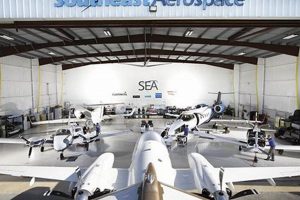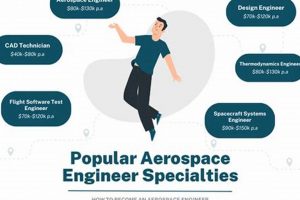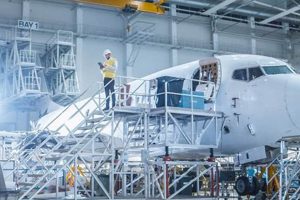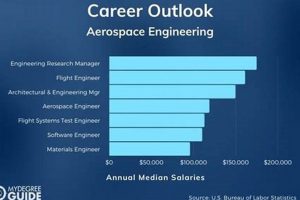The field encompassing the design, development, and maintenance of software systems employed within the aeronautics and astronautics industries is a specialized domain. This area involves creating applications for flight control, simulation, satellite operation, and a multitude of other critical functions. For example, professionals in this sector might develop the guidance systems used in spacecraft or the autopilot software found in commercial airplanes.
Such a career path offers opportunities to contribute to advancements in air and space travel, directly impacting safety, efficiency, and innovation. Historically, advancements in software have been instrumental in enabling increasingly complex and sophisticated aerospace systems, from the first automated flight controls to the sophisticated mission planning software used in modern space exploration.
The following discussion will explore the required skills, typical responsibilities, and career outlook for individuals pursuing opportunities in this demanding and rewarding engineering sector. Specific areas of focus will include relevant educational background, common job roles, and potential for career advancement within the industry.
Guidance for Aspiring Aerospace Software Professionals
Navigating the employment landscape within the intersection of software engineering and the aerospace sector requires a strategic approach. The following tips are intended to provide valuable guidance for individuals seeking opportunities in this specialized field.
Tip 1: Acquire Relevant Educational Credentials: A bachelor’s or master’s degree in computer science, software engineering, aerospace engineering, or a closely related field is generally considered a prerequisite. Coursework should include emphasis on topics such as real-time operating systems, embedded systems, control systems, and numerical methods.
Tip 2: Develop Proficiency in Key Programming Languages: Proficiency in languages such as C, C++, Python, and Ada is often essential, given their prevalence in aerospace applications. Familiarity with scripting languages and software testing frameworks is also advantageous.
Tip 3: Gain Experience with Aerospace-Specific Software and Tools: Familiarity with industry-standard software packages used for modeling, simulation, and analysis, such as MATLAB/Simulink, is highly valued. Experience with version control systems like Git is also crucial for collaborative development.
Tip 4: Pursue Internships and Co-op Opportunities: Practical experience gained through internships or cooperative education programs with aerospace companies or government agencies (e.g., NASA, ESA) can provide invaluable insights and networking opportunities.
Tip 5: Obtain Relevant Certifications: Certifications in areas such as software quality assurance or specific aerospace standards (e.g., DO-178C) can demonstrate a commitment to professional development and enhance credibility.
Tip 6: Build a Strong Online Presence: Maintaining an up-to-date LinkedIn profile showcasing skills, experience, and projects can increase visibility to potential employers. Contributing to open-source projects related to aerospace software can also demonstrate expertise and passion.
Tip 7: Tailor Resumes and Cover Letters: When applying for positions, customize resumes and cover letters to highlight the specific skills and experience that align with the job requirements. Clearly articulate how past experiences have prepared the applicant for the challenges of developing software for aerospace applications.
By adhering to these recommendations, aspiring software professionals can enhance their competitiveness and increase their likelihood of securing employment within the dynamic and challenging aerospace sector. The application of these strategies contributes significantly to career advancement.
The subsequent section will elaborate on the common challenges and future trends impacting the development and implementation of these systems.
1. Required Skills
The skills demanded within the field of software engineering for aerospace applications are stringent and multifaceted. These competencies directly influence the safety, reliability, and performance of critical systems. Proficiency extends beyond conventional software development, encompassing specialized knowledge of aerospace principles and regulatory standards.
- Proficiency in C/C++ and Ada
These programming languages are foundational in aerospace due to their capabilities in developing high-performance, real-time systems. C/C++ allows for low-level hardware interaction, essential for embedded systems, while Ada is often favored for its strong support for safety-critical applications. Examples include flight control systems, where deterministic behavior is paramount, and spacecraft navigation, requiring precise mathematical calculations.
- Knowledge of Real-Time Operating Systems (RTOS)
RTOS are essential for ensuring timely execution of critical tasks in aerospace systems. These systems prioritize tasks based on deadlines and importance, guaranteeing that critical functions, such as emergency procedures, are executed without delay. Flight management systems and satellite control applications are examples where RTOS are indispensable.
- Understanding of Aerospace Standards and Regulations
Compliance with standards such as DO-178C (Software Considerations in Airborne Systems and Equipment Certification) is mandatory for many aerospace software projects. These standards dictate rigorous development processes, testing protocols, and documentation requirements to ensure the safety and reliability of software used in aircraft and spacecraft. Ignorance of these regulations can lead to project delays, increased costs, and potential safety hazards.
- Expertise in Modeling and Simulation Tools
Software engineers in aerospace often utilize tools like MATLAB/Simulink to model and simulate complex systems before implementation. This allows for early detection of potential problems, optimization of system performance, and validation of design decisions. For example, simulations can be used to test the stability of a flight control system under various conditions or to model the behavior of a satellite in orbit.
These skills collectively form the core competencies necessary for success. Without a robust foundation in these areas, it becomes exceedingly difficult to contribute effectively to the development and maintenance of software within the aerospace domain. The ongoing demand for individuals possessing these skills underscores their crucial importance in maintaining the safety and advancing the capabilities of aerospace technology.
2. Job Responsibilities
The specific tasks and duties assigned within positions designated as software engineer in the aerospace sector are diverse and complex, reflecting the critical role these professionals play in ensuring the safety, efficiency, and innovation of air and space travel. These responsibilities directly impact the design, development, testing, and maintenance of software systems integral to aerospace operations.
- Flight Software Development
A primary responsibility involves developing software for aircraft and spacecraft, including flight control systems, navigation systems, and autopilot functionalities. This demands meticulous attention to detail and adherence to stringent safety standards, ensuring the software functions reliably under varying conditions. Examples include coding the algorithms that govern aircraft stability or creating the software responsible for guiding a spacecraft through a complex trajectory.
- Simulation and Modeling
Software engineers create and maintain simulation tools used to model aerospace systems and environments. These simulations are crucial for testing software functionality, predicting system behavior, and identifying potential problems before real-world deployment. For instance, engineers might develop simulations to analyze the aerodynamic performance of a new aircraft design or to model the effects of radiation on satellite electronics.
- Software Testing and Validation
Rigorous testing and validation of software systems are essential to ensure their reliability and safety. This includes developing test plans, executing test cases, and analyzing test results to identify and correct software defects. This phase of development is crucial and will confirm that software components satisfy requirements. Examples include conducting unit tests on individual software modules or performing integration tests on complete systems.
- Maintenance and Upgrades
Maintaining and upgrading existing software systems is another important responsibility. This includes fixing bugs, implementing new features, and adapting software to changing hardware or operational requirements. Engineers need to ensure that updates do not compromise system safety or performance and that changes are thoroughly tested and validated. Examples include updating navigation software to incorporate new airspace regulations or enhancing satellite communication software to improve data transmission rates.
These multifaceted responsibilities underscore the critical role fulfilled by those in roles focused on software within the aerospace sector. Success in these positions requires a combination of technical expertise, problem-solving skills, and a commitment to upholding the highest standards of safety and reliability. The impact of their work extends from enhancing aircraft efficiency to enabling groundbreaking advancements in space exploration.
3. Industry standards
Adherence to established industry standards is a non-negotiable element within the realm of software engineering for aerospace applications. These standards serve as a framework for ensuring the safety, reliability, and performance of software systems deployed in aircraft, spacecraft, and related technologies. Failure to comply with these standards can result in catastrophic consequences, including system failures, loss of life, and significant financial repercussions. Therefore, a thorough understanding and diligent application of relevant standards are paramount for any software engineer working in this sector. The relationship between standards and the profession is causal; adhering to them is critical for successful product and project outcomes. For example, the DO-178C standard, specifically tailored for airborne systems, dictates rigorous processes for software development, verification, and validation. This standard mandates comprehensive testing, documentation, and configuration management procedures, directly impacting how a software engineer designs, codes, and tests flight-critical software. The importance of industry standards cannot be overstated.
Practical application of these standards translates into specific job responsibilities for software engineers. They must be proficient in interpreting and implementing the requirements outlined in relevant standards documents. This includes developing software architectures that are inherently safe and reliable, implementing robust error-handling mechanisms, and conducting thorough testing to verify compliance. For example, a software engineer working on a satellite control system must adhere to standards related to radiation hardening and fault tolerance, ensuring the system can withstand the harsh environment of space and continue operating even in the event of component failures. Regular audits and reviews are conducted to ensure ongoing compliance with these standards, holding software engineers accountable for their implementation.
In summary, industry standards are not merely guidelines but legally binding requirements that shape the daily activities of software engineers working in aerospace. These standards drive the design, development, and testing processes, ensuring the safety and reliability of critical systems. While adhering to these standards may present challenges, such as increased development time and cost, the consequences of non-compliance are far greater. The future of the aerospace industry depends on the unwavering commitment of software engineers to uphold these standards and to continuously improve their practices in line with evolving technologies and regulatory requirements.
4. Compensation Expectations
The anticipated remuneration for positions in the aerospace sector involving software engineering is a crucial element in attracting and retaining qualified professionals. Expectations regarding salary are influenced by a multitude of factors, which are essential for candidates to understand during their job search and career planning.
- Educational Background and Experience
Compensation is directly correlated with the level of education attained and the extent of relevant experience. Individuals holding advanced degrees, such as a Master’s or Ph.D., often command higher salaries, particularly if their research aligns with specific aerospace technologies. Similarly, seasoned engineers with a proven track record of successful project delivery are typically compensated more generously than entry-level candidates. For example, an engineer with ten years of experience developing flight control software can expect a higher salary than a recent graduate.
- Geographic Location
Salaries vary significantly based on geographic location due to differences in the cost of living and the concentration of aerospace companies. Metropolitan areas with a high density of aerospace firms, such as Seattle, Los Angeles, and Huntsville, Alabama, generally offer higher salaries to attract talent. However, the increased cost of living in these areas must also be considered. Conversely, locations with fewer aerospace opportunities may offer lower salaries, though the cost of living may be more affordable.
- Specialized Skills and Certifications
Possessing specialized skills and relevant certifications can significantly impact earning potential. Expertise in areas such as real-time operating systems, embedded systems, and cybersecurity, which are highly valued in aerospace, can command a premium. Certifications related to software safety standards, such as DO-178C, also enhance marketability and earning potential. An engineer certified in DO-178C, for example, is demonstrably qualified to develop safety-critical software for aircraft, justifying a higher salary.
- Company Size and Type
Compensation structures often differ based on the size and type of aerospace company. Large, established corporations may offer more competitive salaries and comprehensive benefits packages, while smaller, start-up companies may offer lower salaries but greater opportunities for equity or rapid career advancement. Government agencies, such as NASA, typically have standardized pay scales that are determined by experience and education level. The specific tradeoffs must be evaluated by each candidate.
These factors collectively shape the landscape of salary expectations for software engineering in the aerospace industry. A comprehensive understanding of these influences enables professionals to effectively navigate the job market, negotiate equitable compensation packages, and strategically plan their career trajectories. Market research combined with an honest assessment of skills and goals is paramount.
5. Educational prerequisites
The attainment of specific educational qualifications serves as a foundational element for entry into roles categorized as “software engineer aerospace jobs.” These prerequisites are not merely academic hurdles; they represent a demonstrated acquisition of the core knowledge and skills essential for successful performance within this demanding field. A bachelor’s degree in computer science, software engineering, aerospace engineering, or a closely related discipline is typically considered the minimum requirement. This academic foundation provides the necessary understanding of programming principles, software development methodologies, and fundamental engineering concepts that underpin aerospace software systems. The cause-and-effect relationship is clear: a rigorous educational background directly enhances an individual’s ability to design, develop, and maintain the complex software systems used in aircraft, spacecraft, and related applications. For instance, coursework in real-time operating systems is critical for engineers working on flight control software, as these systems must respond to inputs within strict time constraints. The absence of such educational grounding significantly diminishes an applicant’s competitiveness and capacity to contribute effectively to aerospace engineering projects.
Beyond the bachelor’s degree, many specialized roles within “software engineer aerospace jobs” may necessitate advanced education. A master’s degree or doctorate can provide deeper expertise in areas such as control systems, embedded systems, or artificial intelligence, making candidates more attractive to employers seeking specialists in these domains. For example, research-intensive positions focused on developing autonomous navigation systems for unmanned aerial vehicles (UAVs) often require a Ph.D. in a relevant field. Furthermore, relevant coursework and projects undertaken during academic studies provide tangible evidence of an applicant’s skills and interests, demonstrating their aptitude for the challenges of aerospace software engineering. Participation in student engineering teams, such as those involved in designing and building rockets or satellites, offers invaluable practical experience that complements theoretical knowledge and significantly enhances career prospects.
In conclusion, educational prerequisites are not arbitrary gatekeepers but rather essential components of the skill set required for success in “software engineer aerospace jobs.” The attainment of a relevant bachelor’s degree is generally considered the minimum standard, while advanced degrees and specialized coursework can provide a competitive advantage. The practical significance of this understanding lies in its ability to guide aspiring aerospace software engineers in making informed decisions about their education and career paths. By focusing on acquiring the necessary educational qualifications and practical experience, individuals can significantly increase their chances of securing fulfilling and impactful roles in this challenging and rewarding field. The challenge lies in keeping pace with the rapidly evolving technological landscape and ensuring that educational curricula remain aligned with industry needs.
6. Company culture
The prevailing ethos within an aerospace organization exerts considerable influence on the success and satisfaction of software engineers. A supportive and innovative environment fosters collaboration, knowledge sharing, and the development of cutting-edge solutions. Conversely, a rigid or bureaucratic culture can stifle creativity, impede progress, and contribute to employee attrition. The direct consequence of cultural alignment, or lack thereof, manifests in project outcomes, employee morale, and the overall reputation of the company. For example, a company that actively promotes continuous learning and provides resources for professional development is more likely to attract and retain talented software engineers who are eager to stay abreast of the latest technologies and methodologies relevant to the aerospace sector.
The practical significance of understanding the connection between company culture and job satisfaction is particularly pronounced in the high-stakes environment of aerospace. Software engineers working on safety-critical systems, such as flight control software, must operate in a culture that prioritizes precision, rigor, and open communication. A culture that encourages constructive criticism and provides mechanisms for addressing concerns without fear of retribution is essential for identifying and mitigating potential risks. Furthermore, organizations that foster a sense of shared purpose and provide opportunities for engineers to contribute to meaningful projects are more likely to cultivate a highly engaged and motivated workforce. For instance, providing engineers with opportunities to work on projects related to space exploration or sustainable aviation can enhance their sense of purpose and commitment.
In summary, company culture is not merely a superficial aspect of “software engineer aerospace jobs” but a critical determinant of employee well-being, project success, and organizational performance. A supportive and innovative culture fosters collaboration, knowledge sharing, and the development of cutting-edge solutions, while a rigid or bureaucratic culture can stifle creativity and impede progress. Aspiring software engineers should carefully evaluate the cultural attributes of prospective employers to ensure alignment with their values and career goals. A key challenge lies in accurately assessing company culture during the recruitment process, which often requires going beyond formal statements and seeking insights from current and former employees. In considering “software engineer aerospace jobs,” candidates should proactively investigate and evaluate company culture as a primary decision factor.
7. Career advancement
Opportunities for professional progression are a significant consideration for individuals pursuing careers in the software engineering field within the aerospace sector. This progression is multifaceted, encompassing technical expertise, leadership roles, and contributions to organizational strategy. Understanding these avenues for career advancement is crucial for long-term career planning and fulfillment.
- Technical Specialization
Advancement can occur through the acquisition of expertise in a specific technical domain within aerospace software engineering. This may involve specializing in areas such as flight control systems, avionics, or satellite communication software. Mastery of these domains allows engineers to assume lead roles in critical projects and contribute to cutting-edge technological developments. For example, a software engineer who develops expertise in DO-178C compliance can advance to a role as a technical lead, guiding teams in the development of safety-critical software.
- Project Management
Software engineers may transition into project management roles, overseeing the planning, execution, and delivery of software projects within the aerospace industry. This path requires the development of strong organizational, communication, and leadership skills. Project managers are responsible for ensuring that projects are completed on time, within budget, and to the required quality standards. An example is a senior software engineer becoming a project manager for the development of a new flight management system.
- Architectural Roles
Experienced software engineers may advance to architectural roles, responsible for designing the overall structure and design of complex software systems. These roles require a deep understanding of software engineering principles, system architecture, and aerospace domain knowledge. Architects play a key role in ensuring that software systems are scalable, maintainable, and secure. An example includes a senior developer becoming a software architect for a satellite communication system.
- Leadership Positions
Advancement can also occur through assuming leadership positions within an aerospace organization. This may involve managing teams of software engineers, leading research and development efforts, or contributing to strategic decision-making. Leadership roles require strong interpersonal skills, strategic thinking, and the ability to inspire and motivate others. A project manager could become a director of software engineering, overseeing multiple teams and projects.
These various pathways highlight the diverse opportunities for progression within “software engineer aerospace jobs.” Whether through deepening technical expertise, developing project management skills, or assuming leadership roles, individuals can chart a fulfilling and impactful career trajectory within this dynamic and challenging field. These are not static paths but rather adaptable to individual strengths and business conditions.
Frequently Asked Questions
The following addresses common inquiries regarding software engineering roles within the aerospace sector. These answers provide clarity on expectations, required qualifications, and career prospects.
Question 1: What specific programming languages are most valued in aerospace software engineering?
The languages C, C++, and Ada are consistently prioritized due to their performance characteristics, real-time capabilities, and adherence to safety-critical standards. Python is also increasingly utilized for scripting, data analysis, and simulation.
Question 2: Is knowledge of aerospace-specific standards, such as DO-178C, essential for employment?
Yes, understanding and experience with relevant aerospace standards are highly valued, and often required, particularly for positions involving flight-critical software. Compliance with these standards is paramount for ensuring safety and reliability.
Question 3: What types of projects might a software engineer work on in the aerospace industry?
Projects encompass a wide range of applications, including flight control systems, navigation systems, satellite communication software, simulation tools, and autonomous vehicle systems.
Question 4: Are internships or co-op experiences beneficial for securing a position in this field?
Indeed, practical experience gained through internships or cooperative education programs significantly enhances an applicant’s competitiveness by providing real-world exposure and valuable industry contacts.
Question 5: What are typical career paths for software engineers in the aerospace industry?
Career paths may lead to roles in technical leadership, project management, software architecture, or research and development. Opportunities for advancement depend on experience, skills, and contributions to the organization.
Question 6: How important is continuous learning in this rapidly evolving field?
Continuous learning is crucial for staying current with technological advancements and maintaining a competitive edge. Software engineers must actively seek opportunities for professional development and acquire new skills to adapt to evolving industry demands.
These answers highlight the key considerations for individuals interested in pursuing a software engineering career in the aerospace sector. Preparation, experience, and continuous learning are critical components of success.
The subsequent section offers additional resources for further exploration.
Conclusion
The preceding analysis has provided a comprehensive overview of “software engineer aerospace jobs,” encompassing required skills, responsibilities, compensation, educational prerequisites, company culture, and career advancement. The investigation emphasizes the critical role of software professionals in advancing safety, efficiency, and innovation within the aeronautics and astronautics industries. Mastery of specific programming languages, adherence to rigorous industry standards, and a commitment to continuous learning are paramount for success in this demanding field.
The future of air and space travel hinges on the ongoing contributions of skilled software engineers. As technology continues to evolve, the demand for qualified professionals in “software engineer aerospace jobs” will remain strong. Aspiring engineers are encouraged to pursue relevant education, gain practical experience, and cultivate a deep understanding of the industry’s unique challenges and opportunities. The advancement of aerospace technology depends on their expertise and dedication.







